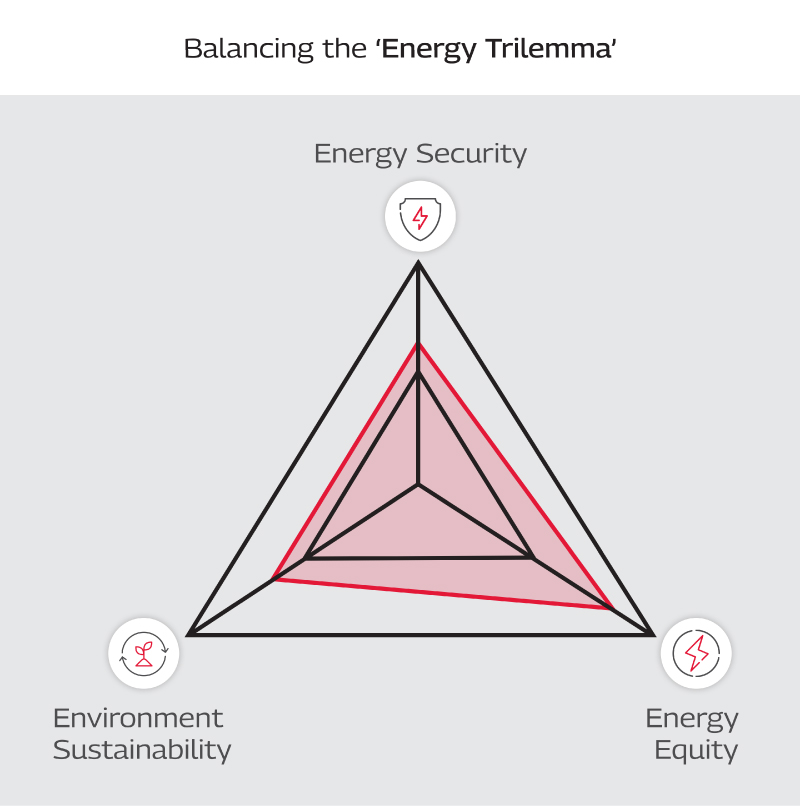Transforming Energy Management: From Data Overload to Smart Insights
Introduction
Picture juggling three key goals in our energy future: keeping the power reliable, the bills affordable, and our planet green. This balancing act is called the Energy Trilemma, a term coined by the World Energy Council. Want cheaper electricity? That might mean compromising on environmental goals. Pushing for 100% clean energy? Costs can go up the roof. This is a constant challenge as utilities work to transform their energy system.
McKinsey estimated that achieving net-zero emissions by 2050 could require cumulative spending of about $275 trillion on physical assets between 2021 and 2050. This could scale up expenses in the short run but result in long-term savings through reduced fuel costs and environmental benefits.

Monitoring Grid Beyond SCADA
Achieving this balance requires a comprehensive knowledge of the grid, something conventional monitoring methods struggled to provide. Traditionally, electricity distribution tracking focused on high-tension (HT) transmission lines and substations, with utilities relying on Supervisory Control and Data Acquisition (SCADA) systems for data collection. They got a limited view of the grid at the transmission level. But with time, the grid has evolved, driven by two factors:
- The rise of affordable, non-invasive sensors provides real-time data on equipment health and performance throughout the network.
- Integrating distributed energy resources (DERs) like battery banks, edge control behind the meter equipment, rooftop solar, wind turbines, and electric vehicles (EVs) has shifted power control from central plants to local sources. This places an unprecedented load on the low-tension (LT) distribution network.
Data now streams at high speeds from diverse sources, such as sensors within substations, rooftop solar panels, distribution transformers, and EV charging stations, creating a more complex, information-rich environment.
Let’s bring the elephant in the room. How can utilities leverage this volume of data effectively?
Harnessing Data for Grid Excellence
Data management is the key for utilities to unlock visibility and control over operations. But the sheer volume, velocity, and variety (3Vs) of incoming data present a major roadblock. For perspective, a US-based utility receives approximately 1.2 million data records daily, accumulating around six petabytes. This includes both structured data from sensors and unstructured data from customer reports. Siloed analytics tools and fragmented datasets further complicate the integration and analysis process.
Data lakes take care of by providing a centralized, scalable repository for diverse grid data in its raw form. They help utilities to unify data silos, unlock advanced analytics with ML and predictive analytics, and improve data accessibility for all stakeholders.
Smart Energy Management Systems in Action
While a data lake provides the foundation, Smart Energy Management Systems (SEMS) optimize energy generation, distribution, and consumption. They leverage AI/ML to transform data into actionable insights, providing intelligence to tackle the Energy Trilemma.
The global energy management system market is experiencing significant growth. Valued at an estimated USD 31.76 billion in 2023, it is predicted to reach USD 112.32 billion by 2032 at a CAGR of 15.3% (Fortune Business Insights).
Let's explore the key SEMS offerings driving this growth:
Virtual Power Plant (VPP) Management: Involves overseeing and optimizing a VPP, a network of DERs, and making it act as a single, dispatchable power plant. It ensures grid stability and maximizes renewable energy use.
Smart Mobility Management: Intelligently integrates EVs into the grid, optimizes power consumption, and keeps charging stations running smoothly.
Edge Computing: Enables autonomous management of substations, transmission lines, and power plants by processing data locally at the edge. This improves grid reliability and security with minimal delays.
Big Data Analytics: Turns mountains of grid data within data lakes into actionable insights, presented through interactive dashboards. Utilities use these dashboards to make data-driven decisions for optimal power distribution. AI/ML models analyze both real-time and historical data to predict energy needs and spot potential issues before they occur.
Distributed Energy Resources Management Systems (DERMS): Monitors, forecasts, and controls grid-connected and behind-the-meter DERs across customer, grid, or market applications in real time. Powered by AI algorithms, it prevents voltage spikes, balances the grid, and optimizes the energy mix to address renewable intermittency. Benefits include:
- Seamless OT system integration
- Optimized energy mix for renewables
- Improved grid reliability
- Economic savings with resilience and power quality
- Enables 4X rooftop solar PV adoption
Maximizing Efficiency and Reliability with SEMS
SEMS significantly improve energy management for utilities by leveraging AI/ML and edge computing to optimize consumption and conservation. Imagine predicting potential failure within two weeks, helping households shift their EV charging to midnight when rates are low, or scheduling maintenance during off-peak hours.
By implementing these systems, utilities can unlock the benefits, from enhanced reliability and efficiency to greater consumer empowerment:
1. Enhanced Grid Management
- Real-time Monitoring: Identify high-demand areas, grid congestion, and potential outages in real time.
- Self-Healing Grids: Automate fault detection, isolation, and restoration in the network. These grids use sensors, algorithms, and automated switches to identify the location and nature of faults, monitor frequency and voltage, balance loads, and reduce outages. With these capabilities, this market expects to hit $2.48 billion in 2025 from $2.28 billion in 2024, at a CAGR of 8.8%(The Business Research Company).
- Predictive Maintenance: Leverage data-driven insights (based on big data analytics) to anticipate equipment failures, optimize maintenance schedules, and extend asset lifespan.
2. Improved Efficiency
- Demand Response Management: Incentivize consumers to shift peak usage, flattening demand, and reducing costs.
- Optimized Power Flow: Minimize transmission losses by analyzing and optimizing grid conditions.
- Distribution Automation: Improve power quality and minimize energy loss through automated voltage and frequency regulation.
3. Consumer Empowerment
- Enhanced Customer Experience: Empower consumers with real-time usage data and dynamic pricing options (peak/off-peak hours) to help them shift non-essential loads and reduce bills.
- Edge Situational Awareness: Provide them with real-time insights on energy sources, costs, and carbon footprints to help them take informed decisions about lower-cost options.
- Efficient DER Management: Integrate DERs into VPPs to help utilities manage these assets and optimize renewable energy use.
Tech Mahindra: Your Trusted Partner in Smart Energy Transformation
Transforming a traditional power grid into a smart, data-driven network requires more than technology. It demands a thorough grasp of grid operations, data flows, and key performance indicators (KPIs), the key to unlocking the power of SEMS. That's where Tech Mahindra steps in as a strategic technology partner who understands these challenges.
We've invested in comprehensive SEMS expertise, building solutions from edge device integration and data lake construction to customized AI/ML models and intuitive dashboards for actionable insights. With proven experience in complex data management, we guide utilities to turn information into an operational advantage.
Conclusion
Data is the cornerstone of modern grid management. When data lakes converge with SEMS, utilities gain the intelligence to navigate today's energy domain. With Tech Mahindra's SEMS expertise, utilities can finally master the balancing act of the Energy Trilemma.
Endnotes
- Krishnan M, Samandari H, Woetzel L, Smit S, Pacthod D, Pinner D, Naucler T, Tai H, Farr A, Wu W, Imperato D. (2022, January 25). The economic transformation: What would change in the net-zero transition. McKinsey Sustainability
- (2025, February 3). Energy Management System Market Size, Share & Industry Analysis. Fortune Business Insights
- (2025, January). Self-Healing Grid Global Market Report 2025. The Business Research Company
Prem is responsible for driving vertical business growth, enhancing customer engagement, conceptualizing and developing industry-specific solutions, and building a robust partnership ecosystem. With over 30 years of experience in the utilities industry, he has expertise across the entire value chain of Power, Water, and Wastewater Businesses.








